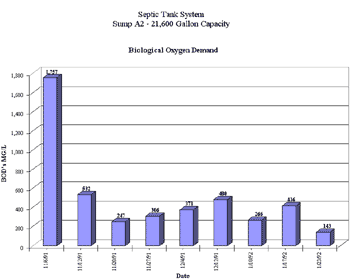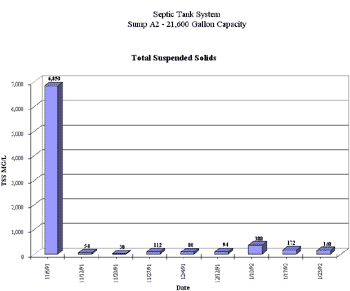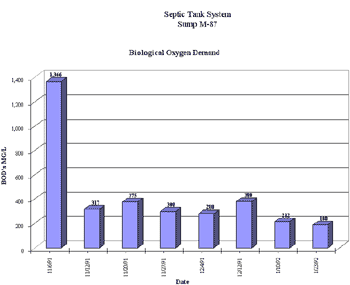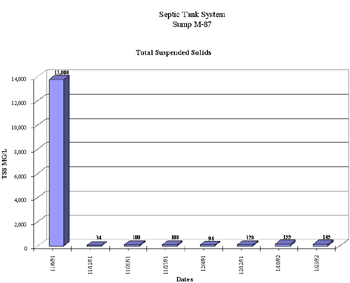
Biocatalytic Remediation
November 6, 1991 - January 23, 1992
Dysfunctional Septic Tank System
Graphs on the following pages demonstrate the bio-remediation of a septic tank system, which had ceased to operate and was brought into substantial EPA compliance and odors gone within eight days of infusion of biocatalytic agents. The system was stabilized within 60 days while digestion of accumulated solids progressed. Anticipated length for total digestion was an additional 90-120 days with treatment moving to maintenance infusion at that time.
SUMMARY
As the graphs indicate, biocatalytic treatment began in the septic tank system on November 6, 1991. Samples were taken from the treated tanks weekly thereafter, except for the period December 12, 1991 to January 3, 1992. Security at this defense installation is stringent and the holidays intervened to prevent unaccompanied and/or unbadged personnel from visiting the treatment sites.
All samples were analyzed for critical indices by a third party, the city sewage treatment plant laboratory. A lab technician certified results. Numbers are reflected in the graphs that follow. They show that within eight days of beginning the treatment process indices for total suspended solids and biological oxygen d emand dropped dramatically and the system was, with marginal exceptions, in compliance with EPA requirements.
Not shown in the graphs are other significant phenomena. Odors dropped significantly within three or four days and were virtually nonexistent in two weeks. The protocol called for treatment of the influent at source points in the administration buildings and cafeteria, such as toilets, urinals, dishwashers, kitchen and floor drains, garbage disposals, etc. Personnel were cautioned that typically this treatment would detach large slabs of grease and fat buildup attaching to the interior of the conduit lines. Treatment must therefore be no more or less than prescribed to prevent this process happening too rapidly and clogging one or more of these lines.
The on-site treatment supervisor noted slabs of these deposits coming down the line into the diversion box about two weeks into the treatment. He observed one about three feet long and quite a number of "floaters" of lesser size. If this buildup had continued an expensive line stoppage and backup into the facilities was inevit able and merely a matter of time. He also noted that before treatment began there was a grease blanket about five feet thick in the diversion box. He had used a 350mm polypropylene pipe to measure the thickness and the plant supervisor, who is a very powerful man, had some difficulty forcing the pipe through the blanket. After three weeks of treatment the pipe could be easily passed through the two or three inch crust and slid down the rest of the way to the sump floor from its own weight. The blanket was digested down to about half its initial thickness and the residue was now more jellylike in consistency. It is estimated that the accumulation of years of solid residues in the tanks are now perhaps 50% digested. Lines to the tanks, which had been stopped, have become increasingly more free flowing.
The drain fields for the 'A' series tanks are south from the rocket park and across the road. The plant supervisor reported that prior to the treatment accumulation of solids had resulted in extremely poor drainage and a consequent surface puddling of the effluent from the tanks. As the anaerobes permeated the system these solids were broken up and digested. Although conditions are the most adverse at this time of year for such an event the fields are now draining and the pace is accelerating.
It is appropriate to note that the plant supervisor's highly professional and constant monitoring of the system and feedback of his observations and data played an important part in producing an almost perfect model of product performance. Management formally acknowledged this in a letter of commendation and cash award, noting a savings to the facility of $20,000.
Contact Us
Phone: 541-388-4546
Email: drsenviro@gmail.com



